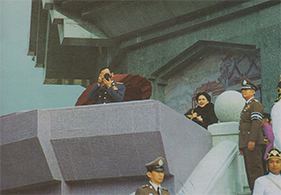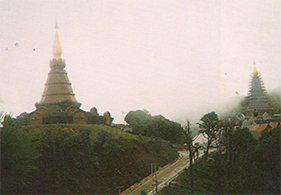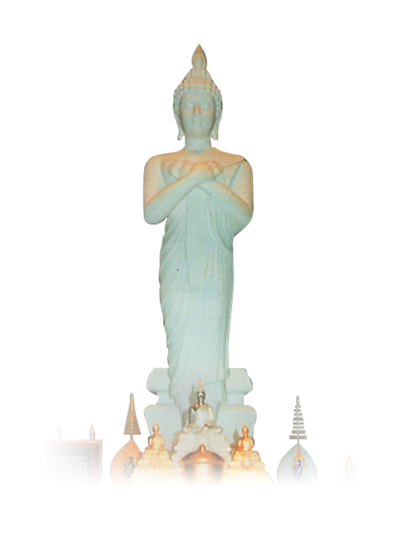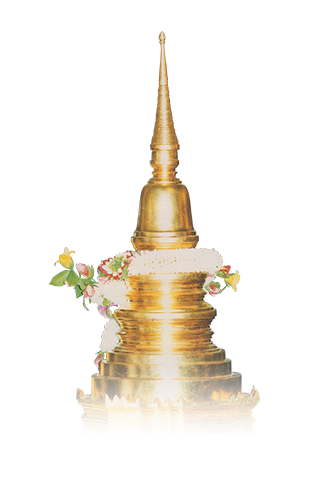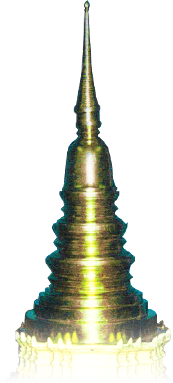
The pagoda’s body is alike Nabhamethanidol’s. It’s 12 sided polygons shape. Circled with 2 levels terraces for Buddhists and visitors do clockwise spiritual act and walk around to see scenery. The pagoda’s lower terrace is 37 meters wide and 55 meters high which is 5 meters shorter than Nabhamethanidol pagoda to represent that Her Majesty the Queen Sirikit is 5 years younger than His Majesty the King Bhumobol.
At the top triangle of the pagoda enshrining Buddha relics which encloses replicated Hariphunchai relics by divided into 4 parts, one from Queen Sirikit, one from Somdet Phra Nyanasamvara, Thailand’s Supreme Patriarch, one from Sri Lanka government and another one from RTAF Commander-in- Chief and other faithful people.
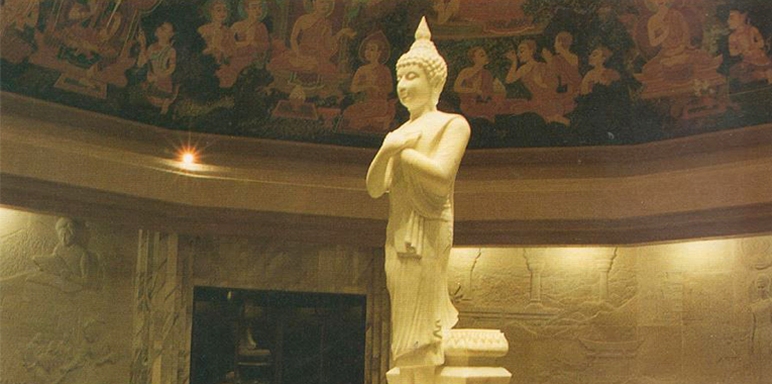
Inside the pagoda’s hall is decorated with images of royal duties, carved granite stones at the bottom of the wall inside. The upper wall is decorated with glass mosaic which arranged images and colors with computer, ordered from Italy. In the middle of the hall enshrined Buddha statue in contemplation attitude, which is Queen Sirikit’s birthday Buddha image. It’s carved from pure white jade stone from People’s Republic of China. Its body is 3.20 meters high, weight 5 tons. This is one of the biggest and most beautiful white jade stone Buddha statue.
Construction took 900 days to complete, costs around 135 million baht. Budget is from the government 48 million baht. Other budget is from faithful people donated total 87 million baht. In this budget, some is Queen Sirikit’s personal fund mercifully conferred to be starting fund for this project. This brought happiness and gratefulness to concerned staffs so much.
RTAF arranged a ceremony for delivering pagoda Nabhapolbhumisiri on March 8th, 1993 by King Bhumibol came to be president of the ceremony together with Queen Sirikit. Their action showing that the appreciated and happy all the time they walked around and took a look at decoration of the pagoda, both outside and inside, made fellows overwhelmed and made RTAF members so proud that they have united to build an exclusive bethow on the highest mountain of Thailand to be memorial of worship and loyalty towards King Bhumibol and Queen Sirikit like nothing can compare.
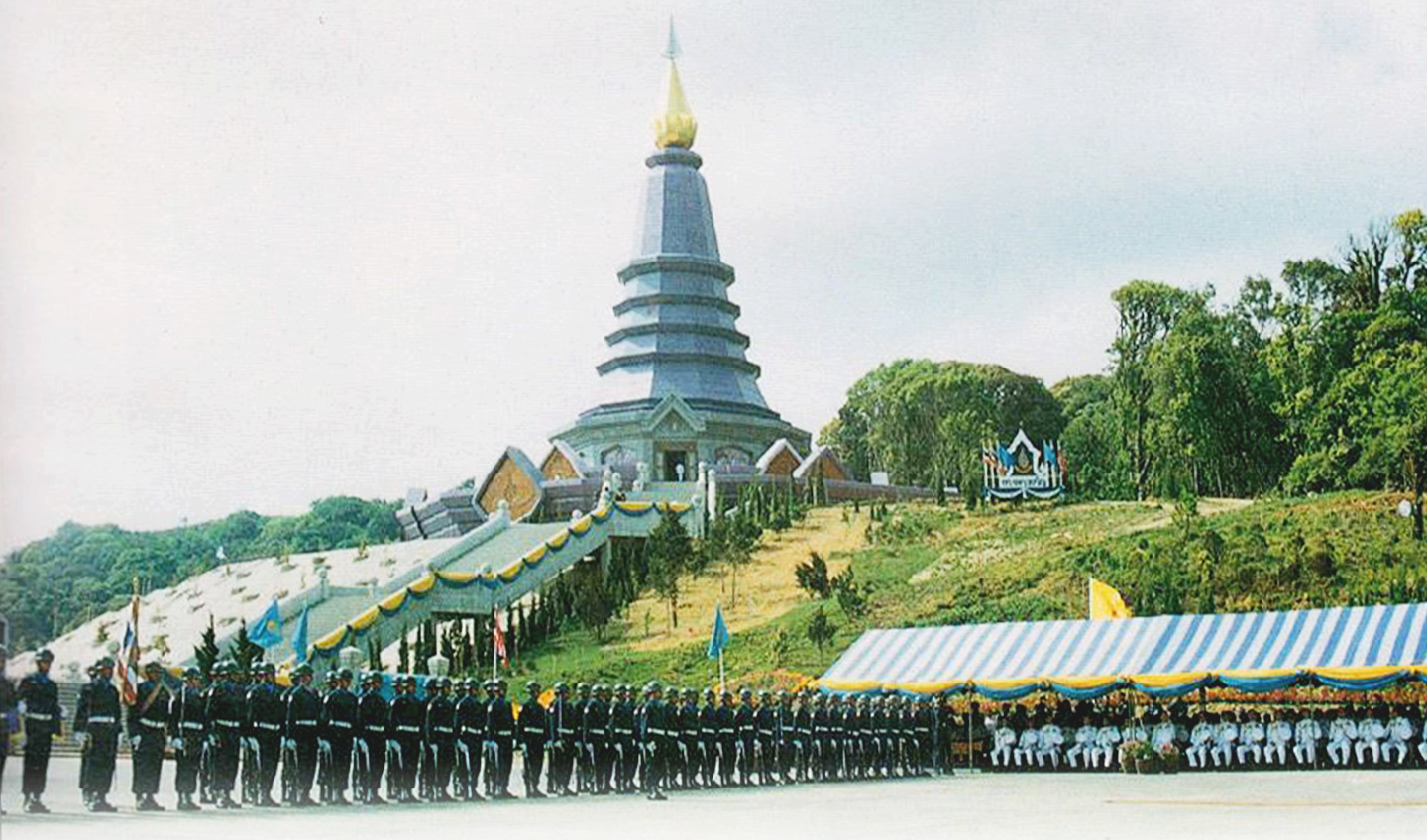
The Great Holy Relics Pagoda Nabhapolbhumisiri
This pagoda’s shape is like Nabhamethanidol pagoda which RTAF built and dedicated to King Bhumibol in auspicious occasion of His 60th birthday on December 5th, 1987. There are some difference anyway about their appearance and other components which represents different meaning, which is, image of Nabhpmethanidol pagoda represents Lord Buddha’s enlightenment. Its decoration inside showing Lord Buddha’s previous reincantations and his brief biography. Colors and decorated materials have strong, stable and noble characteristics like a warrior. For Nabhapolbhumisiri pagoda’s appearance represents components that support Lord Buddha to achieved enlightenment. Its decoration inside showing role of women who supported and encouraged Buddhism to be arose in this world. Color and materials used both inside and outside the pagoda showing beauty and sweetness just like Thai women’s.
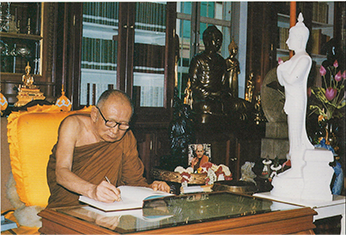
Designer team, which is the same team who design Nabhamethanidol pagoda consisting of Prof.Khaisri Tansiri, specialist in architecture, Ministry of Public Health, as a chief, Mr.Santi Chayasombat as an architect and Mr.Kanchanachak Sathapanasoot as an engineer. They laid down the concepts as follows.
First, they made it to looked alike Nabhamethanidol pagoda, which is different from ancient Lanna artistic style because they wanted to make it a modern architecture on the highest place of Thailand. The design expressed using straight lines cross one another to make polygons to represents stability and steadiness.
Second, decoration inside, outside and other components of the pagoda represents appreciation and admiration of women that have supported and encouraged Buddhism to be arose in this world.
When we set our primary idea this way, designer team went to visit Somdet Phra Nyanasamvara, the Supreme Patriarch to asked him to consider. So he agreed and mercifully searched and granted dhamma to be idea for designing. The pagoda’s appearance represents 2 topics from this idea as follows;
- 1. 37 Bodhipakkhiya dhamma or 37 things pertaining to enlightenment.
- 2. 12 intellectuals or 12 miracles which happened to Siri Mahamaya, Buddha’s mother, which is result of her performance of giving and determined to be mother of Buddha from previous life.

Team of designers has designed Nabhapolbhumisiri pagoda to be 12 edged polygons which represents 12 intellectuals. There are 2 wide terraces in different level for Buddhist and visitors doing clockwise spiritual act or walk around to see scenery. Lower terrace is 37 meters wide represents 37 Bodhipakkhiya dhamma. At the terrace’s curbs lies 6 lotus shape arches. At the top of the pagoda lies a triangle shape enveloped with lotus lobes and put Buddha relics inside, parted with 9-tiered chatra which made out of silver metal. Inside the pagoda is a high ceiling hall. There are 3 entrances. Front entrance is opposite of Nabhamethanidol pagoda’s. There are stairs connect from pagoda to landings below. The pagoda is 55 meters height from landings to the top, which is 5 meters shorter than Nabhamethanidol pagoda to represent that Queen Sirikit is 5 years younger than King Bhumibol.
The pagoda’s image is designed to represent 37 dharma i.e. 4 establishments of mindfulness, 4 right exertions, 4 bases of power, 5 faculties, 5 powers, 7 factors for Enlightenment and noble eightfold path which assembled to be 37 things pertaining to enlightenment. There is a lotus enveloped the pagoda’s lower body. They divided this pagoda into 4 parts to represent 4 establishment of mindfulness. Upper of this part is a 25 small tiers representing 25 dharmas which are elements of persistence to Enlightenment, consisting of 4 establishments of mindfulness, 4 right exertions, 4 bases of power, 5 faculties, 5 powers, 7 factors for Enlightenment. For the noble eightfold path, it’s shown at the neck of the bell which designed to be 8 tiers base. The top triangle of the pagoda is enveloped with lobes of budding lotus, representing awakening which leads to enlightenment, which is different from Nabhamethanidol’s top triangle that enveloped with blooming lotus which means already enlightened.
Construction.
It was starting from leveling the area which was a hill behind the pavilion, located around 75 meters from Nabhamethanidol to the north, at 18 degree, 33 minutes, 33 seconds North latitude and 98 degree, 28 minutes, 51 seconds east longitude. They were 2 connected bald mountains. Area of the front of the hill is around 1,400 sq.m. set to be pagoda construction area. Area of the back of the hill is around 4,800 sq.m. set to be gardens for people who come to worship and visitors to relax here. RTAF has assigned Civil Engineering of the Air Force to grade this area. by Gp.Capt.Sombat Sukhonthong, Director of Air Field Division responsible for this job and there were 9 staffs.
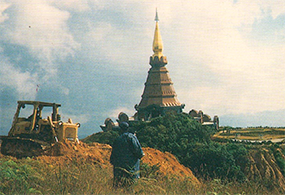
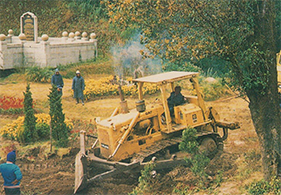

To level this area, they cut the top of the hill 15 meters out to make the base of this pagoda the same level as the previous one and push cut-soil around 36,000 m³ to pile at the hillside on the east. This type of soil is sandy soil which easily collapses with tide from heavy rain in rainy season, so they dug big drainages around this area to control raindrop which fall on the yard not to erode soil that they piled on the hillside to relief soil collapse. But when rainy season came, it turned out that soil collapse was far from our plan due to it’s sandy soil, it’s attachment is poor. When it rains, water that soaked in the soil will make it heavier and slide down plate by plate. Especially in the steep area and causes soil rutted. It looks terrible and some place looks awful. So when rainy season ended, Civil Engineering of the Air Force sent some staffs to adjust ground level again to make it more slope. Squadron Leader Sawas Meemang was in charge.
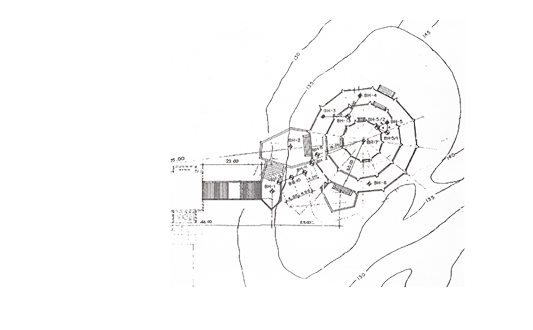
For foundation design, RTAF hired Krungthep Engineering Consultants Co.,Ltd. to explore under budget of 298,000 baht, to drill at least 7 holes and total depth at least 105 meters. The contractor spent about 30 days to proceed. They drilled 4 inches diameter holes by using spinning drill in the first place and wash boring. For the rest of the process, they had to stop before reaching 15 meters deep because they hit stone layer. In the beginning they set 7 holes to be drilled but they drilled more up to 15 holes, gain total depth 106.5 meters. They also test soil quality both on the field and in the lab. The result is it’s sandy soil all the way and every holes. The upper part of the hole is low to medium density soil and it’s high to very high density soil in the lower part. The area of the pagoda’s ascent and the hill found thick sandy soil layer. It’s about 7 meters deep from its surface. Some parts are more than 15 meters deep. But for the construction area they found just shallow sandy soil layer only around 2.1 to 6.7 meters.
Designer team considered that stone layers the discovered are in very different depth and safety weight of spread footing of sandy soil at the construction area is 20 tons per sq.m. maximum. So they decided to use auger press piles to bear the weight by putting the end of the stake on the stone layer or thick sandy soil layer. Plus, due to stone layers are in different depths, if they use driven pile, it would be impossible to fix the length of each pile and it’s also difficult to transport. So they chose auger press piles instead.

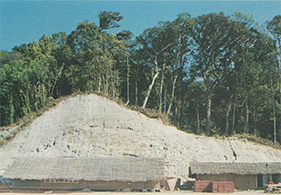
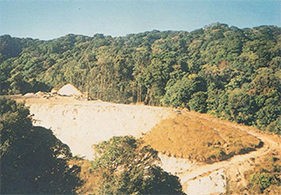
After graded the ground and drill to test soil quality already, designer team and the Construction Board have set up pagoda’s location and other components up to stairways on the plan to examine whether the space is enough for every components and suitability of the plan in actual landscape.
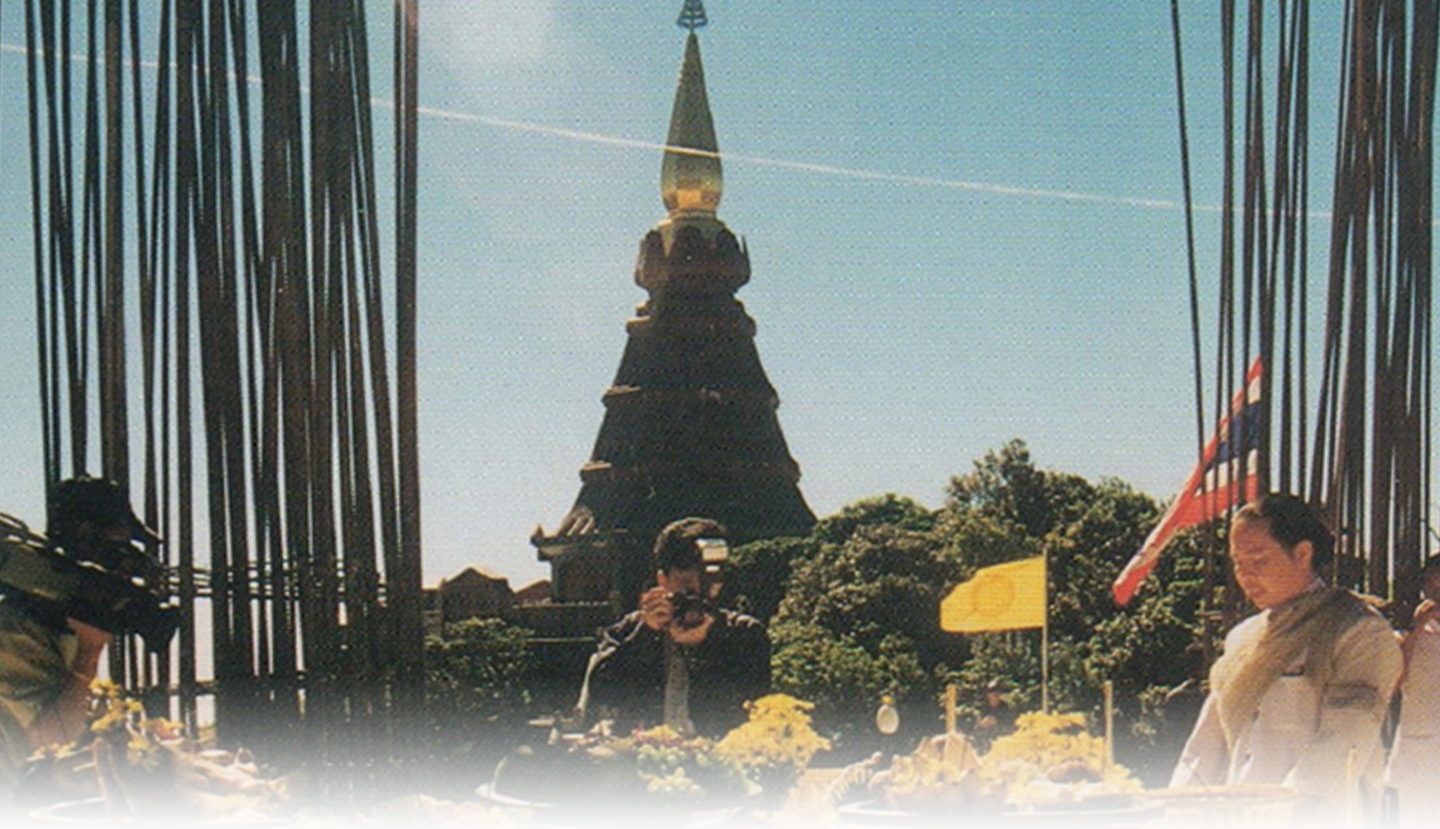
Groundbreaking Ceremony
RTAF performed groundbreaking ceremony on January 11th, 1991 at 12:19 p.m. by ACM Kaset Rojjananil, RTAF Commander-in- Chief was the president of the ceremony.
This ceremony was set according to Lanna’s (ancient northern Thailand) tradition which Phra Kru Prachakpattanakhun, abbot of Saen Fang temple, Chiang Mai as master of the Lanna ceremony.
The ceremony started with holy spirit worship i.e. ancestral kings and ancestors, Kru Ba Sriwichai, along with angels and guardian spirits on Intanon mountain to be notification and invitation them to congratulate with this construction.
Before the ceremony started, Phra Kru Prachakpattanakhun and other 4 Buddhist monks performed a rite to remove all unfortunate things from this area to make it pure.
After performing holy spirits worship in all 5 places was done, RTAF Commander-in-Chief- in-Chief and his fellows performed a groundbreaking ceremony at the middle position of the pagoda. This groundbreaking stone lies under the pagoda’s hall, hang about 1 meter higher from the floor, enclosed with glass to be clearly visible. The place where they put this stone pedestal is a big hall, suitable to adapt to be resting area for visitors in rainy season and winter in the future.
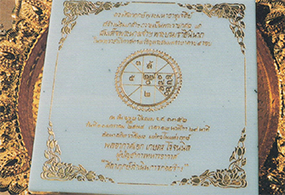
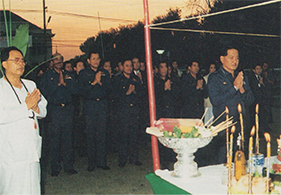
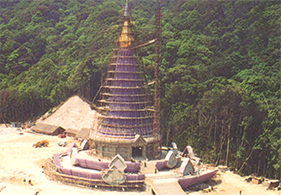
After finishing groundbreaking ceremony, in the next morning, Saen Fang abbot had mercifully perform a rite to consign merit to souls of Lanna ancestors and angels to be notification and apology from something intrusive during construction and asking for protection for all workers and concerned people to finish this project safely, with no harm at all. ACM Somsak Kusalasai, Director of Construction Board, as a president of the ceremony.
After groundbreaking ceremony was done, construction was continuous proceed and Audit Committee have checked and took over the job on October 11th, 1991.
Earlier, they supposed to decorate the hall’s ceiling with color mosaic in Sal flower pattern. Lower wall at the same level as a door facade decorated with images of Buddha’s biography carved from granite stone. The rest of wall area decorated with marble which is the same as Nabhamethanidol’s interior. RTAF Commander-in-Chief commented that there should be Queen Sirikit’s crucial royal duties images decorated inside the pagoda’s hall, too so that people who come to worship and visit will be able to remind her mercy that she has upon all Thai people in our memory forever to tribute to Her Majesty the Queen Sirikit according to the project’s objective. Construction Board and designer team had been asking for advice from the Supreme Patriarch to make sure about appropriation and he granted. So designer team decided to install images of Queen Sirikit’s royal duties carved with granite stone on the pagoda’s lower inside wall. For Buddha biography images, decorated at the upper wall by changing from granite stone carving to be color mosaic glass from Italy.
Images of Queen Sirikit’s Royal Duties, Inside the pagoda’s hall is a 12 edges polygons shape. There are 3 entrance arches. There are 3 parts of walls between each arch. Construction and Decoration Board has arranged Her Majesty’s royal duties images in 3 groups to cover her crucial fields of duties. Gp.Capt.Sumamal Palawan as image arranger and hired Saksilapanich granite stone shop to carve them.
These images combined bas-relief and high-relief style, carved from white granite stone from Chanthaburi. Each image in this set is 13.30 meters wide, 3.40 meters high and 25 centimeters thick. It’s a big carved granite stone image. When installation was done, they still carved more more details which showed their tidiness and smoothness. This made these images more beautiful than they expected and made King Bhumibol and Queen Sirikit happy with them so much.
Images in the first group represents Queen Sirikit’s proficiency in doing royal duties on King Bhumibol’s behalf and standing aside him both domestic and international. Being Thai people’s role model to be aware about their duties they should do for their country, religion and royal institute along with their compatriot.
So images in this group are about being King’s regent, pictures of visiting overseas and visiting police and soldiers to encourage them to protect their own country.

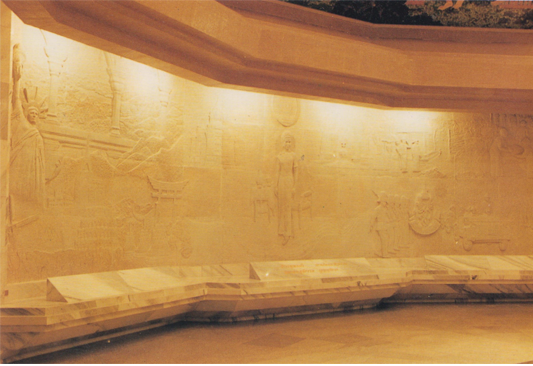
We, servants of His great Majesty,
Prostrate our heart and head,
To pay respect to the ruler, whose merits are boundless,
Images in the second group showing Queen Sirikit’s determination toward helping people in countryside to have better life by suggested and supported handmade jobs in home industry by applying local materials to be clothes, ornaments, tools and other accessories. This is not only helping rural people earn money and raise their living quality, yet it still be inheritance of valued local art for posterity to admire them in the future, too. This reputation is famous and appreciated worldwide. Food and Agriculture Organization of the United Nations voted to offer Ceres medal in 1979 to honor her and to be medal for her royal duties on social service and supporting her people to have better, stable lives and going forward. Moreover, United Nations Educational, Scientific and Cultural Organization or UNESCO also offered Borobudur Gold Medal to salute her because of her mercy about supporting arts and creativities.
So images in this group are about her visitation and suggestion her people about how to restore local handcraft artistic, Ceres medal and image of Queen Sirikit among cattleya, roses and Dona flowers which already asked her for permission to grant a name “Dona Queen Sirikit” for her honor.
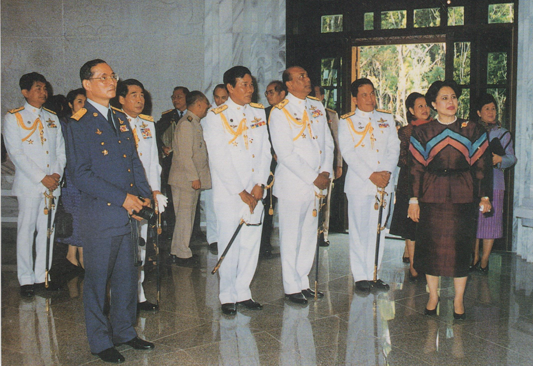
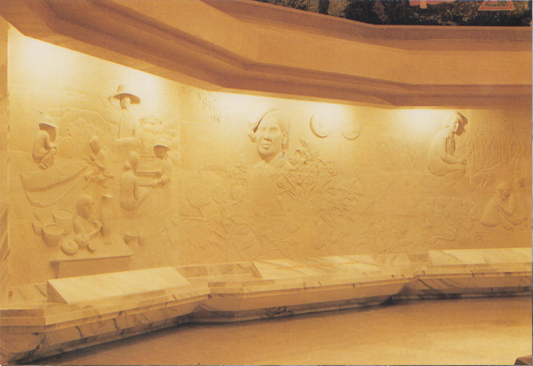
Our glorious sovereign ,
The greatest of Siam,
With great and lasting honor,
Images in the 3rd group represents her motherhood over Thai people that she always be generous and cares her people in every section who suffered either from drought, natural disaster and even sickness either physical or mental issues. She has visited her people to encourage without caring any difficulties or danger that could happen to her. This royal grace touch deep in Thai people’s heart. This royal grace doesn’t limited to only Thai people but also spread to refugees from our neighboring countries, too. This grace made supporters of Children’s Museum (Washington DC) voted to offer her International Humanitarian Award to honor her for being sponsor and supportive countless humanitarian works. This is the first time this reward is given to non-American people.
So images in this group are about her visitation her people in tough regions, supporting religions, along with images of campaign on saving forests and upstream to solve drought from original cause.
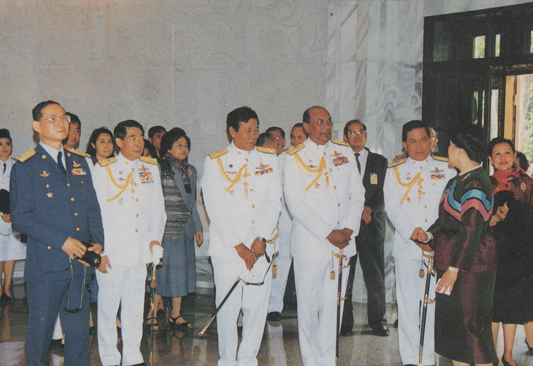
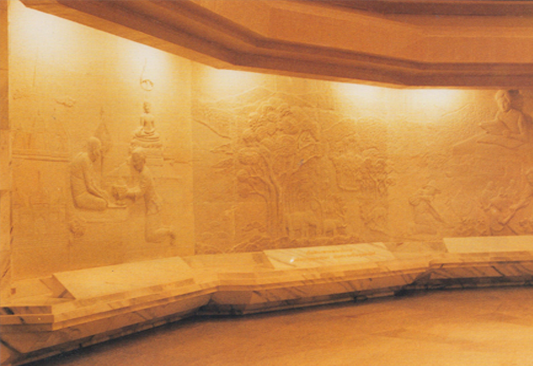
(We are) secure and peaceful because of your royal rule,
The result of royal protection
(is) people in happiness and in peace,
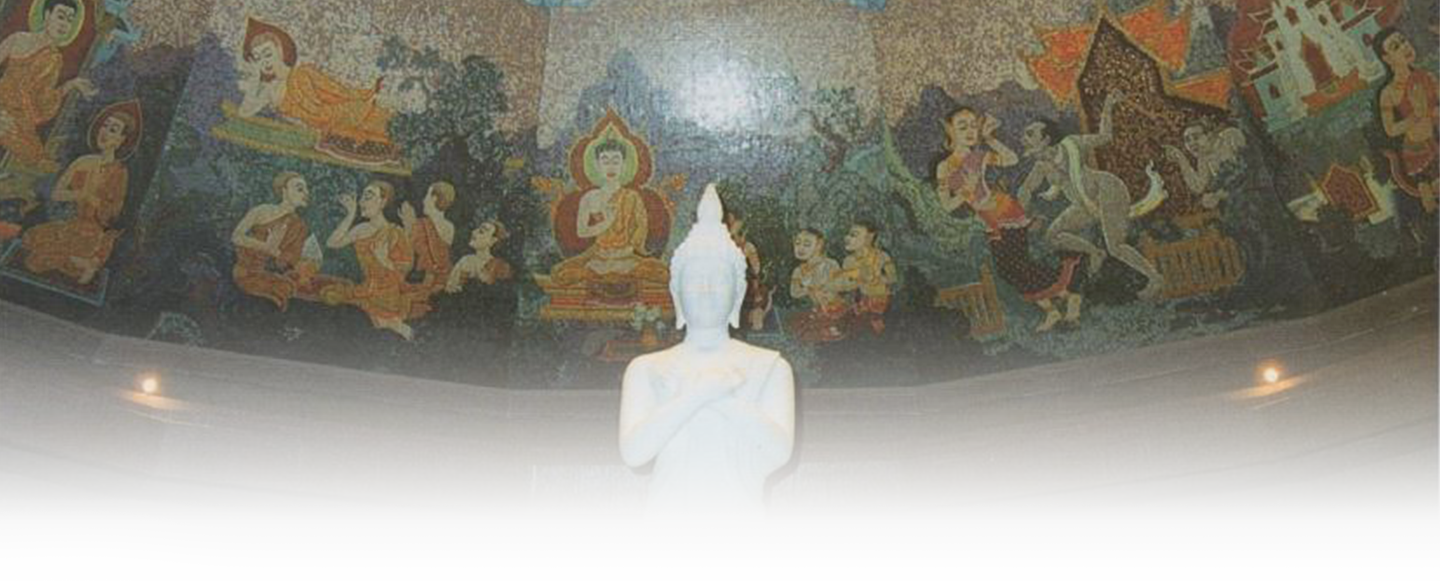
Walls inside the pagoda’s hall are decorated with images of Buddha’s biography made out of glass mosaic which were arranged both images and color by computer. They are special ordered from Italy, presents story of Queen Siri Mahamaya, Queen Mahaprajapati Gotami, princess Yasodhara (wife of Buddha) and Visakha (great female supporter) which were people who took key roles in supporting Buddhism to be arose in this world, including supported Buddhism to be inherited until nowadays, total 12 pictures ;
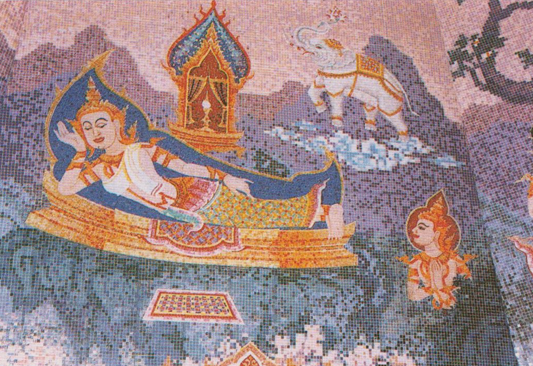
picture 1 Queen Siri Mahamaya was dreaming
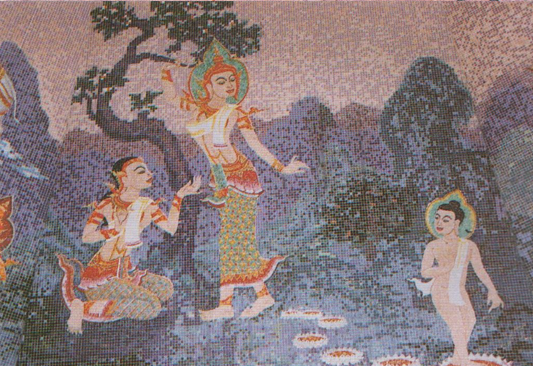
picture 2 Queen Siri Mahamaya gave birth to Bodhisattva under sal tree

picture 3 Buddha was preaching Deva Sandusit
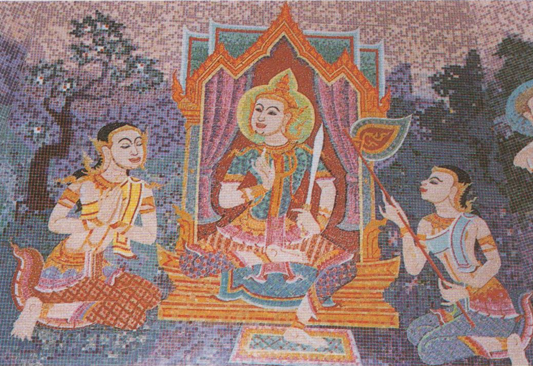
picture 4 Queen Maha Prajapati Gotami was raising Bodhisattva

picture 5 Buddha was ordaining Queen Maha Prajapati Gotami to be bhikkhuni (priestess)
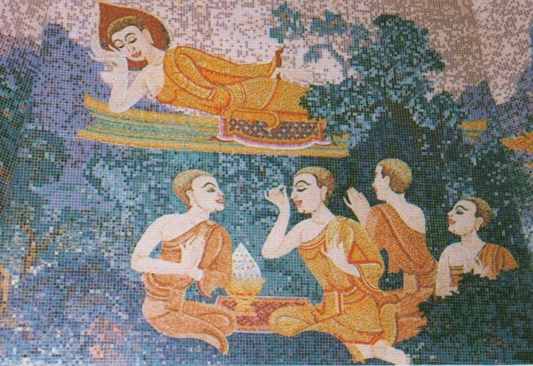
picture 6 Queen Maha Prajapati Gotami went to nirvana
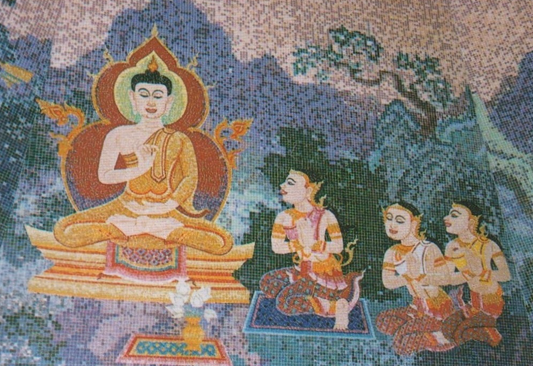
picture 7 Visakha, the great female supporter, was listening to Buddha’s preachment
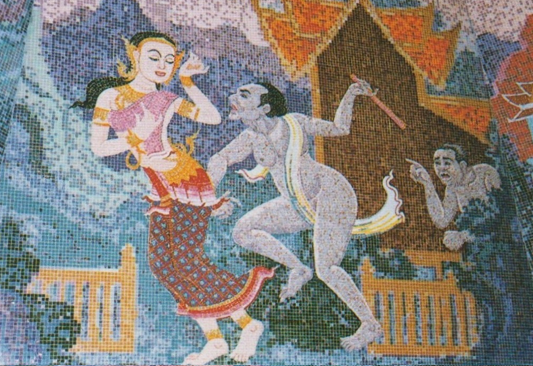
picture 8 Visakha was exiled from Migara the millionaire
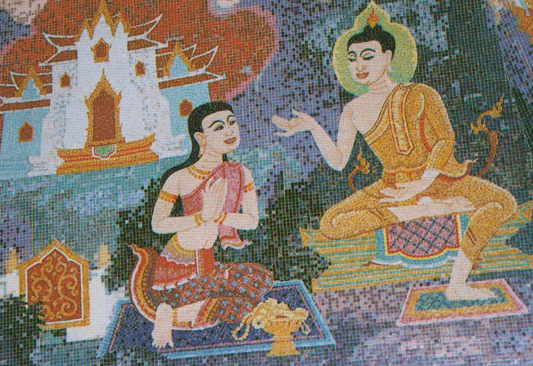
picture 9 Visakha offered metallic castle
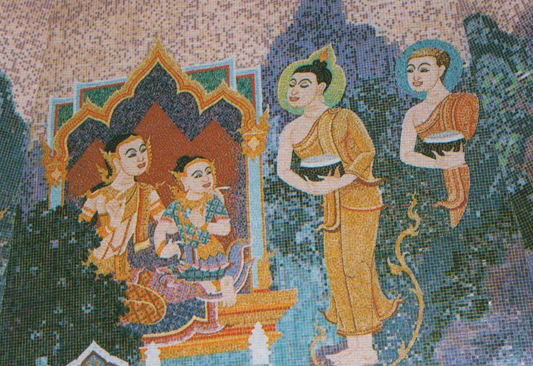
picture 10 Princess Yasodhara asked for treasure for Rahula

picture 11 Buddha explaining to Prince Yasodhara about outer and inner treasure
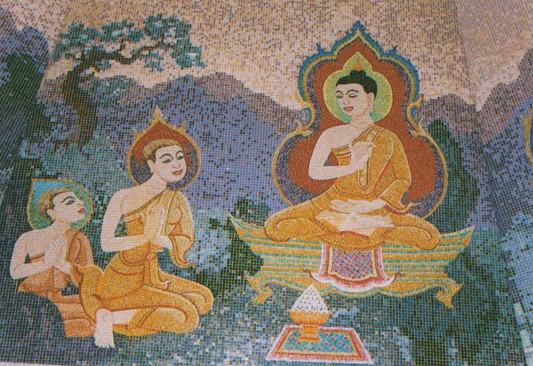
picture 12 Buddha was ordaining Prince Yasodhara to be bhikkhuni
Picture 1 : When Bodhisattva almost leave Tusita heaven to born as human and enlighten to be Buddha, Queen Siri Mahamaya dreamt about great white elephant
Picture 2 : When Queen Siri Mahamaya pregnant at the 10th month, she was willing to go to Devadaha to give birth. But when she arrived Lumbini Vana garden, she birthed Bodhisattva under sal tree shade. Bodhisattva walked 7 steps which was a sign that he will missionary into 7 states in India.
Picture 3 : Queen Siri Mahamaya died 7 days later after gave birth to Bodhisattva and reborn in Tusita heaven becoming Deva Sandusit. When Bodhisattva enlightened and become Buddha, he remind of his mother so he visited Tavatimsa heaven, place of worship and asked Sakra deva to invite Sandusit Deva to see him. Then he preached Sandusit Deva for gratitude.
Picture 4 : After Queen Siri Mahamaya passed away, Queen Maha Prajapati Gotami, Bodhisattva’s aunt, has raised him just like his own mother until he grew up.
Picture 5 : When Bodhisattva went ordain and he already enlightened and become Buddha, one time, Queen Maha Prajapati Gotami wanted to ordain, too. So she came to Buddha to ask for ordaining. He granted and ordain her to become bhikkhuni (priestess) . So she is the first bhikkhuni in Buddhism. Later, she is accepted as an Etadagga (the first or the best of the class) in having longest experience in priesthood (female side).
Picture 6 : Priest Maha Prajapati Gotami lived her age until the end. She farewell Buddha and went to nirvana at priestess school in Mahavana, the large natural forest near Vaishali ancient city.
Picture 7 : Visakha the great female supporter was daughter of Dhananjaya, a treasurer of the city of Bhaddiya in Agra. When he was 7, Mendhaka-Setthi (her grandfather) assigned her to welcome Buddha. She listened to his preachment and achieved Sotapanna (stream-enterer). Later on, her father moved to live in Saket city and married Punnavaddhana, the son of Migara the treasurer. Then she moved to live with her husband’s family in Savatthi.
Picture 8 : Migara’s family believed in nudist cult, not Buddhism. One day there came a Buddhist monk to receive food. Migara pretended not seeing him. So Visakha said to the monk that “Please go ahead, my husband’s father is eating old food.” This made Migara angry and exiled her from the family. But after investigation by millionaire who was authorized for this case, it turned out that she was not guilty. So Migara had to let her stay and allowed her to do merit with Buddhist monks. She invited Buddha to had meal and he preached to Migara until he admired.
Picture 9 : Visakha the great female supporter had an very expensive ornament name Mahalatapasadhana which costs 90 million. One time she wore this ornament to an important party and went on Buppharam temple which she built it and dedicated to Buddha. She took off this ornament and let her servant kept it. Her servant holds it for long time and felt fatigue so she put it on the banister inside the church and forgot it there. Until she left the temple and just recall so she went back to find it. She found that Phra Anon kept it. Visakha thought that if the priest already touches it, she got to offer it. But due to priest cannot use it, so she announced for selling but nobody bought it. So she bought it by herself and took that money to build metallic castle and dedicated it to Buddha. It’s a very large monastery that contains 1,000 rooms.
Picture 10 : Princess Yasodhara, Sitthatta’s wife and Rahula’s mother, due to before Bodhisattva went ordain, there were treasures at 4 corners of the city. But after Bodhisattva went ordain, all treasures are gone. When Buddha came back to Kapilavatthu, she told Rahula to ask for those treasures. Buddha considered that outer treasures are unsustainable so he gave Rahula inner treasures which is mercily ordained Rahula to be novice. So Rahula is counted as the first novice in Buddhism.
Picture 11 : Rahula’s ordaining made Princess Yasodhara so sad. So Buddha explained her about outer and inner treasures until she understood.
Picture 12 : Princess Yasodhara asked to be ordained. Buddha granted. So she was ordained and become another priestess in Buddhism.
At the ceiling of the hall are decorated with brown Sal flower glass mosaic, containing 2 layers of lobe and 12 lobes each layer which adjust brightness 1 bulb per 1 lobe, split outer and inner lobes with dark brown color, attached a tubular lamp at the bottom of each lobe which can adjust brightness and adjust beam at inner lobes to project to the Buddha statue. Moreover, there are lamps projecting beam to Buddha’s biography images and Her Majesty’s royal duties images nicely. When we turn on all light in the hall, it will be bright, beam project to Buddha statue Phra Buddha Sirikit Dighayumonggol to make it more outstanding. Furthermore, beam projected to images of Queen Sirikit’s royal duties which tenderly set them at the right angles and brightness make these images more contrast and more beautiful.
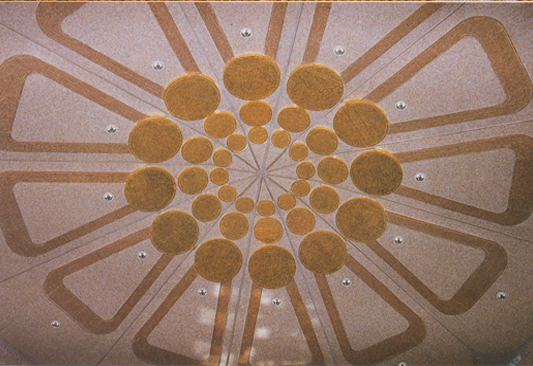
Sal flower : Its appearance looks like Negkassar flower but bigger. Sal flower is relevant to Buddha. He was born under sal tree which legend says, at that time it was blooming looked delightful. When Buddha went to nirvana, he also slept on the pedestal between 2 blooming sal trees, too. So it’s a flower which means a lot to Buddhist spirit.
First thing that the pagoda Nabhaphumisiri draws attention for visitors is its color. It’s pinkish purple. Along with its tender shape with lotus wrapped around its body that makes it look different from other pagoda. When we go closer, we will see coating baked clay images which their color match with the pagoda’s surface and brown bake clay images which are decorated at light purple arches are contrasted with purple terrace walls. At the pagoda’s top is a golden triangle shape parted with 9-tiered Chatra.
Materials used for Decorate the Pagoda ; Terrace walls and arch frames around pagoda’s body including top triangle are glass mosaic special ordered from Italy in total around 3,150 sq.m. The rest of pagoda’s walls decorated with polished whitish gray granite stone. Floor inside pagoda’s hall and both levels of terraces tiled with polished blackish gray granite stone.
The top triangle of the pagoda which is circled with lobes of budded lotus are made out of golden glass mosaic from Italy. Mosaic’s look is clear glass wrapped gold sheet inside. It shines when it reflexes sunlight it shines just like it’s covered with gold sheet. Up ahead is parted with 9-tiered Chatra made out of silver metal, carved with pattern in every tier. Height from the bottom tier to the top of the highest tier is 4.50 meters. The bottom tier is 1.80 meters. The top tier made out of brass, designed and created by prof.Pinyo Suwannakhiri
The pagoda’s body decorated with pinkish purple glass mosaic all over its body. But with reflexing of light and shadow makes us see its shape clearly.
Pagoda’s surface decorated with 9 baked clay images. They show story of bhikkhuni who is the best of them in Buddha’s age. All images are tendered, beautiful color. Main color is purple matched with the pagoda’s surface color. This is working of Mr.Wanchoke and Mr.Wanchai Krisdamahasakul, twins brothers of Nakorn Thai Ceramics Co.,Ltd., Muang district, Nakhon Pathom.
To paint according to the plan, they had to mix a hundred of colors and to make sure they will get the exact color as planned, they took all mixed colors to test by firing glaze method until they got the exact color the need. They spent total 90 days to test colors. Bas relief sculptures around this pagoda are showing about last life and present life of bhikkhunis who persisted until they enlightened and became Etadagga respectively as follows;

Picture 1 Khema bhikkhuni, bhikkhuni of a great wisdom
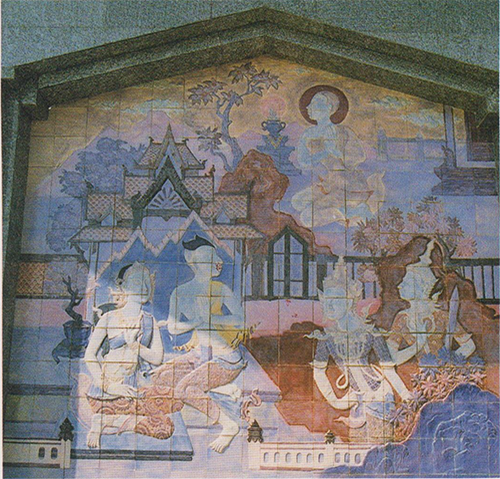
Picture 2 Upolvanna bhikkhuni, bhikkhuni of a great supernatural power

Picture 3 Patacara bhikkhuni, bhikkhuni of a great strict disciplinarian
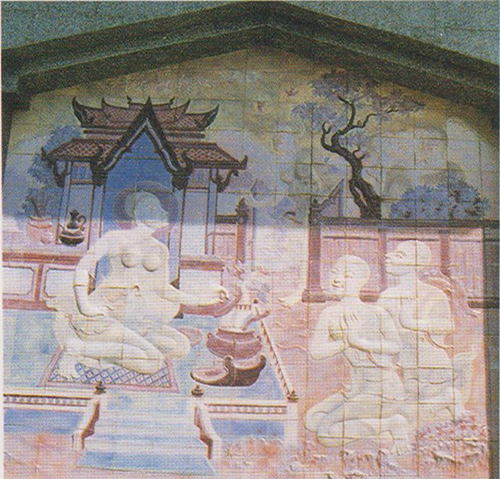
Picture 4 Sona bhikkhuni, bhikkhuni of a great effort
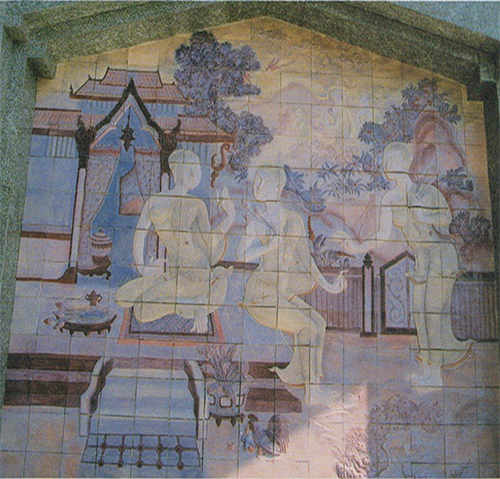
Picture 5 Nanda bhikkhuni, bhikkhuni of a great Jhana attainment
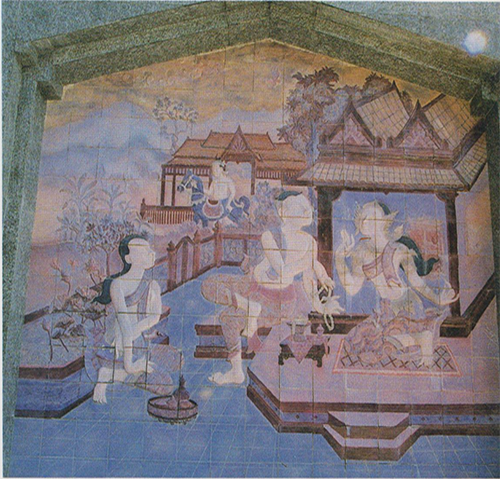
Picture 6 Dhammadinna bhikkhuni, bhikkhuni of a great sermon giver
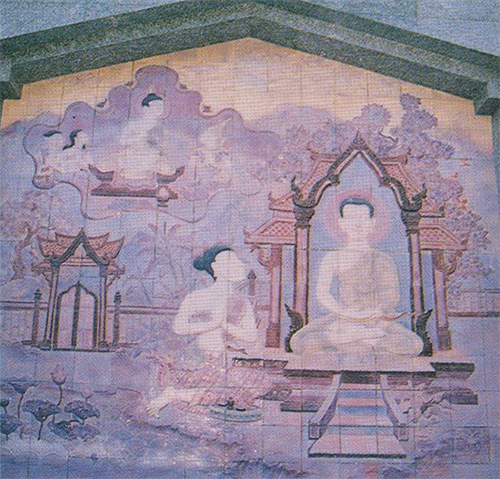
Picture 7 Sakula bhikkhuni, bhikkhuni of a great devine eyes
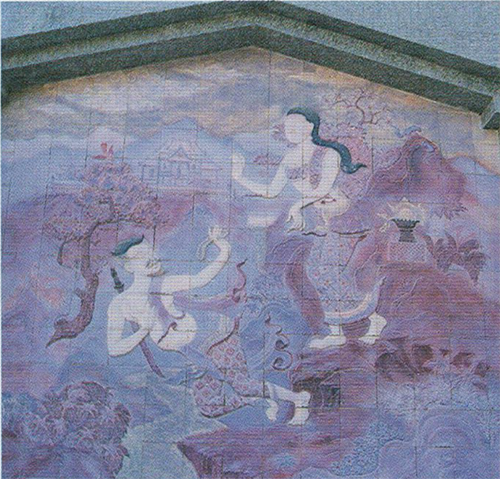
Picture 8 Bhaddakundolkesa bhikkhuni, bhikkhuni who attained enlightenment quickly

Picture 9 Bhaddakapilani bhikkhuni, bhikkhuni who was great at remembering former existences.
All 9 sculpted images showing stories of 9 bhikkhunis are installed respectively, the first image is on the left of the entrance and are in clockwise order.
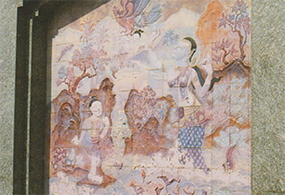
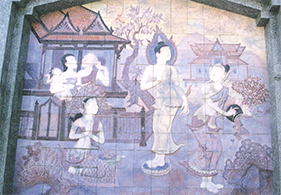
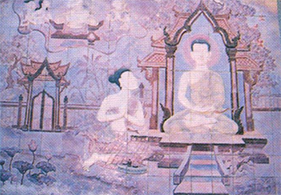
Terrace arches around pagoda are decorated with baked clay images coated with brown imitate natural color of earth. This makes terrace arches looks outstandingly beautiful and makes the pagoda looks more artistic. There are images of 6 realms of heaven at inner side of the upper terrace arch. For outer side lies images of 6 female supporters who were excellent in each field. For inner side of lower arch lies images of 3 great female supporters and 3 bhikkhunis who were excellent in each field that Buddha praised them. Outer side of lower terrace arches contains images of RTAF winged logo. All 24 decorated images at each terrace arch, Sub Lieutenant Pradit Sriwichainan took this job. He assigned professors and students from Faculty of Fine Arts, Chiang Mai University to sculpted and did fire glaze method just like images around pagoda’s body but this is matte glaze method.
Sculptures at outer side of upper terrace shows stories of female supporters who concentrated on dharma since previous life and wished to be born in Buddha scape in order to do merit and dedicated to Buddha and being authorized to be Etadagga that they are excellent than other female supporters as follows ;
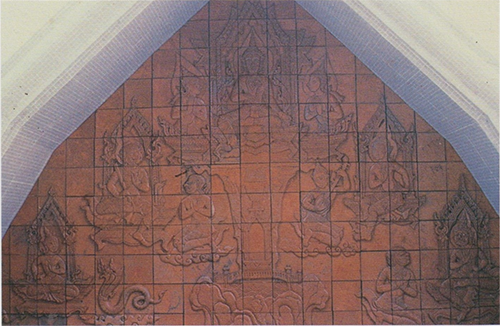
Picture 1 Supavasa Koliyadhita, foremost of the upasikas, offering the best food
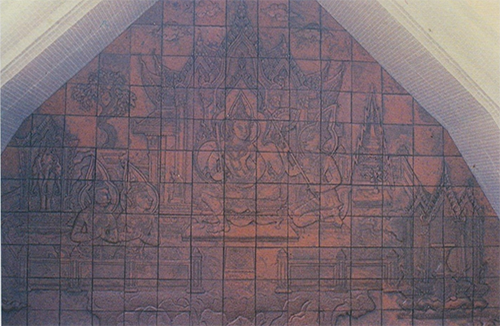
Picture 2 Nakulamata, foremost of the upasikas, the closest upasika to Buddha
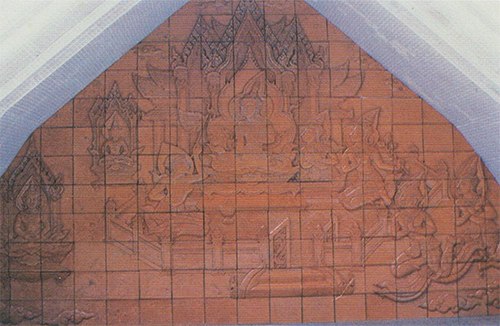
Picture 3 Nandamata, foremost of the upasikas, the one who pleased in Jhana
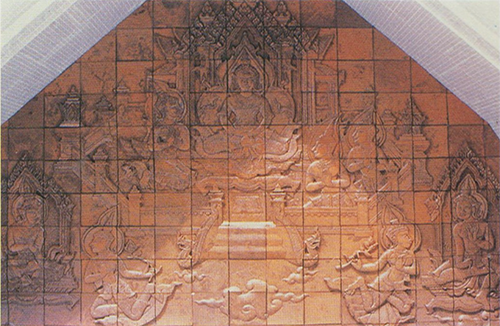
Picture 4 Kali upasika, foremost of the upasikas, the one who believed even from hearsay
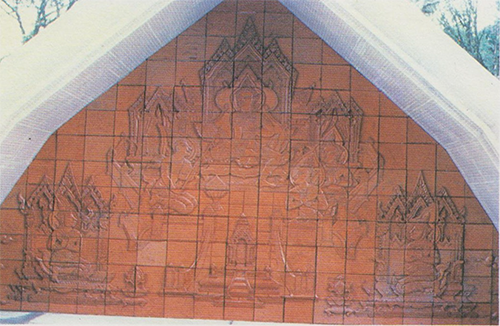
Picture 5 Suppiya upasika, foremost of the upasikas, the lay-disciple who devote herself in nursing sick monks
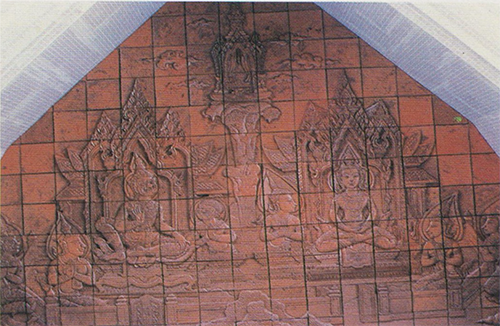
Picture 6 Katiyani upasika, foremost of the upasikas, who had unshakable faith
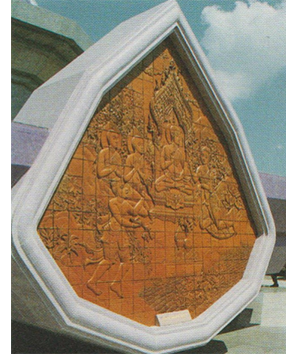
Sculptures at the inner side of lower terrace shows stories of excellent bhikkhunis and upasikas who were ordained and attained enlightenment at the last stage of their lives as follows;
Picture 1 Kisagotami, bhikkhuni who wore old gloomy yellow robe.
Picture 2 Singalamata, bhikkhuni who achieved by faith.
Picture 3 Anocha, bhikkhuni who concentrated.
Picture 4 Sona, upasika of the great effort.
Picture 5 Baddakaccana, upasika of super knowledge.
Picture 6 Samawati, upasika of living mercy
Sculptures at the inner side of upper terrace are about heaven realms as follows ;
Picture 1 First realm : Catummaharaja : ruled by Catummaharaja deva
Picture 2 Second realm : Tavatimsa : ruled by Sakra deva
Picture 3 Third realm : Yama : ruled by Suyama deva
Picture 4 Fourth realm : Tusita : ruled by Sandusit deva
Picture 5 Fifth realm : Nimmanarati : relued by Sunimmit deva
Picture 6 Sixth realm : Paranimmitavasavatti : ruled by Savatti deva
On top of 3 entrance’s arches are engaged Her Majesty Queen Sirikit’s monogram to be her honor and for visitors can come and worship and visit the pagoda remind of her merit and appreciate it forever and after. In this engagement, Phra Kruba Thuang from Wat Ban Den temple, Mae Taeng district, Chiang Mai had mercifully suggested to perform ceremony on December 24th, 1992 at 11:00 a.m.
The entrances consist of 2 layers, inner doors are aluminum sliding door, padded with light brown glass. Outer doors are swinging doors. Casing and jamb were made out of stainless steel, padded with clear mirror. Casings are carved with reddish gold alloy material.
There are 129 steps of stairway to the pagoda, tiled with rough granite stone. Landings tiled with rough granite stone framed with polished granite stone. Banisters tiled with rough granite stone just like stairways. At the top of each newel posts decorated with round shape granite stone matched with newel posts of the pagoda and at the lower split landings which connected to Nabhamethanidol pagoda’s, there is a stone inscription describes about construction of Nabhapolbhumisiri pagoda in a position that balanced to Nabhamethanidol pagoda’s.
Landscape

Character of soil at the area they were going to build pagoda is sandy soil that contains sand only in the top layer only. Deeper down there are only sand, no other organic compound at all.
To decorate area around Nabhapolbhumisiri, they made a big garden with a fountain in the middle. Pathway tiled with artificial granite stone, lay down around the garden area for worshiper and visitors to rest and see beauty of vegetation and scenery of both pagodas. There is a small garden in front of scenic area. Next to the gardens are hillsides sloping to parking lot which decorated with groups of tree bushes. At the bottom of the hill, the pagoda’s name plate, there are small gardens for visitors to take photos.
There are approximately 7,800 ornamental plants in this projects. Containing plants in family of Chinese juniper, creeping juniper, shore juniper, false heather, bloodleaf, azalea, Japanese ginseng and local plants i.e. wild himalayan cherry, peach, vanilla siamensis, tree marigold and kesiya pine for example. For flowering plants, they rotate various seasonal plants to grow.
| White jade stone being carved, Buddha image - Buddha character is mercifully contemplating attitude. |
| “Sirikiti Dighayumonggol” Queen Sirikit granted this name |
| Enshrined on a beautiful base, bow three times for worship, causing happiness, glory and auspicious things. |
| Just like Buddha taught people about what deserved to be worship |
| Causing auspicious things and glories, persuades our mind into goodness |
| Embroider words for flowers, make it colorful, and represent candles and incenses to worship. |
A Buddha statue that enshrined as a principle Buddha image at the middle of Nabhapolbhumisiri pagoda’s hall is in contemplation attitude, an attitude of Friday which is Queen Sirikit’s day of birth. It was carved out of white jade stone (Han Bai Yu) from People’s Republic of China. Its height (considered only statue’s body) is 3.20 meters, standing on a blooming lotus, its outer robe is laying on the bench. It weighs about 5 tons. We can say that this is one of the biggest and most beautiful white jade stone Buddha statue. It granted its name from Queen Sirikit that “Phra Buddha Sirikit Dighayumonggol” means Buddha is auspicious and long live the Queen Sirikit.
Carving this Buddha statue by Chinese craftsmen were very tidy in every process since choosing a whole white jade stone. Chinese craftsmen finally found one. Especially its bottom which needed a large stone, they had to change 3 stones at that time because when they carved deeper inside, they found some gray spots.
For carving, Chinese craftsmen started from molding clay model in actual size from plaster template 90 centimeters high which was designed by Mr.Laemsingh Ditthapan. When they done molding clay model, they removed moulded plaster by divided into 2 parts. They divided the statue’s hips into 2 parts because size of the statue including its base is 3.80 meters. They cannot find any stone that is big enough to make it. Then they took this plaster mound to be template of carving later.
Chinese craftsmen’s carving was done by using tools to measure deep and shallow marks neatly, then they carved one mark at a time. So its size and depth are exactly the same as original model. Most of all is going in details that there might be some differences from the original model due to lack of understanding in artistic style such as its eyes which looking low. Thailand’s Air Attaché on Beijing, Gp.Capt.Kuakul Watthanasak (his rank at that moment) saw this mistake so he sent Mr.Laemsingh Ditthapan and Gp.Capt.Sumamal Phonlawan to make adjustment.
When the statue was enshrined already, RTAF has performed incantation ceremony and opening Buddha’s eyes. Along with engaging Buddha relics to be enshrined at the top triangle of the pagoda on March 29th, 1993.
When Somdet Phra Nyanasamvara, Thailand’s Supreme Patriarch, gave Buddha relics to RTAF Commander-in- Chief-in- Chief to be enshrined on the top triangle of the pagoda, he also gave other parts of Buddha relics to put in the bun of this Buddha statue, too. On February 26th, 1993, he came to perform containing rite by himself.
Buddha Relics
To build Nabhapolphumisiri pagoda, they engaged Buddha relics from temple of the Sacred Tooth, Kandy, Sri Lanka which they believed that this Buddha relics are parted share from Kushinagar after Buddha’s funeral, and they engaged it to be enshrined on the top triangle of the pagoda together with some parts from faithful people as follows ;
Buddha relics from Queen Sirikit donated.
Buddha relics from Somdet Phra Nyanasamvara, Thailand’s Supreme Patriarch, donated.
Buddha relics from RTAF Commander-in- Chief, Air Force officers and faithful people donated.
Buddha relics which engaged from Sri Lanka. Sri Lanka government performed offering formality to RTAF Commander-in- Chief on January 3rd, 1993 at chapel of temple of the Sacred Tooth, Malwatta temple, Kandy.
Receiving Buddha Relics
Receiving Buddha Relics Formality from Sri Lanka Government at Malwatta Temple, Kandy, Sri Lanka. In the morning of January 2nd, 1993, ACM Kaset Rojjananil, RTAF Commander-in- Chief and his fellows along with clergy containing 8 priests, left Don Muang airport to Colombo, Sri Lanka by Air Bus 310.
Clergy that travel this time are as follows ;
1. Somdej Phra Buddhacarya (Kiaw Upseno), from Wat Saket Ratcha Wora Maha Wihan, primate of East sector, acting Supreme Patriarch of Thailand
2. Phra Panyavajiraporn, secretary of Somdej Phra Buddhacarya
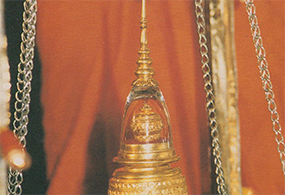
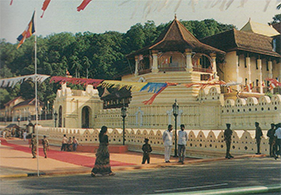
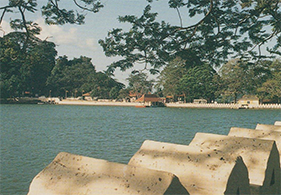
3. Phra Atthakijkosol, Wat Bowonniwet Vihara
4. Phra Sumontissa, Wat Bowonniwet Vihara
5. Phra Maha Suwit Piyawitcho, Wat Bowonniwet Vihara
6. Phra Khru Visutdhammaros, abbot of Don Muang temple
7. Phra Khru Boolvorakhun, Wat Lat Sanun
8. Phra Khru Phisonviharakij, Vice Abbot of Wat Phra Si Mahathat
The ceremony started with Mr.Niranchan led the honor procession regarding to tradition to welcome RTAF Commander-in- Chief and Sri Lanka President at the yard in front of Sacred Tooth chapel, then led the procession into the chapel.
When the procession got inside the chapel, Mr.Niranchan took RTAF Commander-in- Chief and his fellows, along with Sri Lanka President and Prime minister to perform Buddha relics worship ceremony at the upper stairs of the chapel. This worship used flower tray with pedestal which RTAF has prepared and another one is jasmine tray with pedestal that Mr.Niranchan prepared, along with 32 small dishes for Buddha image (including both food and dessert). Then Mr.Niranchan took Buddha relics that Sri Lanka government prepared to the ceremony area. After that, RTAF Commander-in- Chief made a speech to show his intention to receive these Buddha relics. Moreover, he also wants to tighten relationship between Thai and Sri Lanka Buddhists. After that, Sri Lanka President made a speech on behalf of Sri Lanka people. When his speech ended, he passed it to RTAF Commander-in- Chief while Buddhist monks were preaching incantation spell.
After the ceremony, RTAF Commander-in- Chief’s team engaged Buddha relics to Colombo by car procession by Sri Lanka government. They fly back to Don Muang airport around 07:30 p.m.
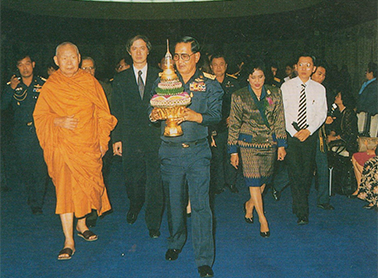
At RTAF Head Quarter
RTAF Commander-in- Chief engaged Buddha relics from the airplane and enshrined them at RTAF reception room so that senior RTAF officers and other people who came to receive them this time could worship them altogether. Division of Quartermaster RTAF has arranged garlands and floral chaplets for every attendant.
There were not only senior RTAF officers, general officers, employees and their families, there were also Buddhist monks from various temples around Don Muang area, Sri Lanka ambassador in Thailand and a lot of people who heard about this event came to join.
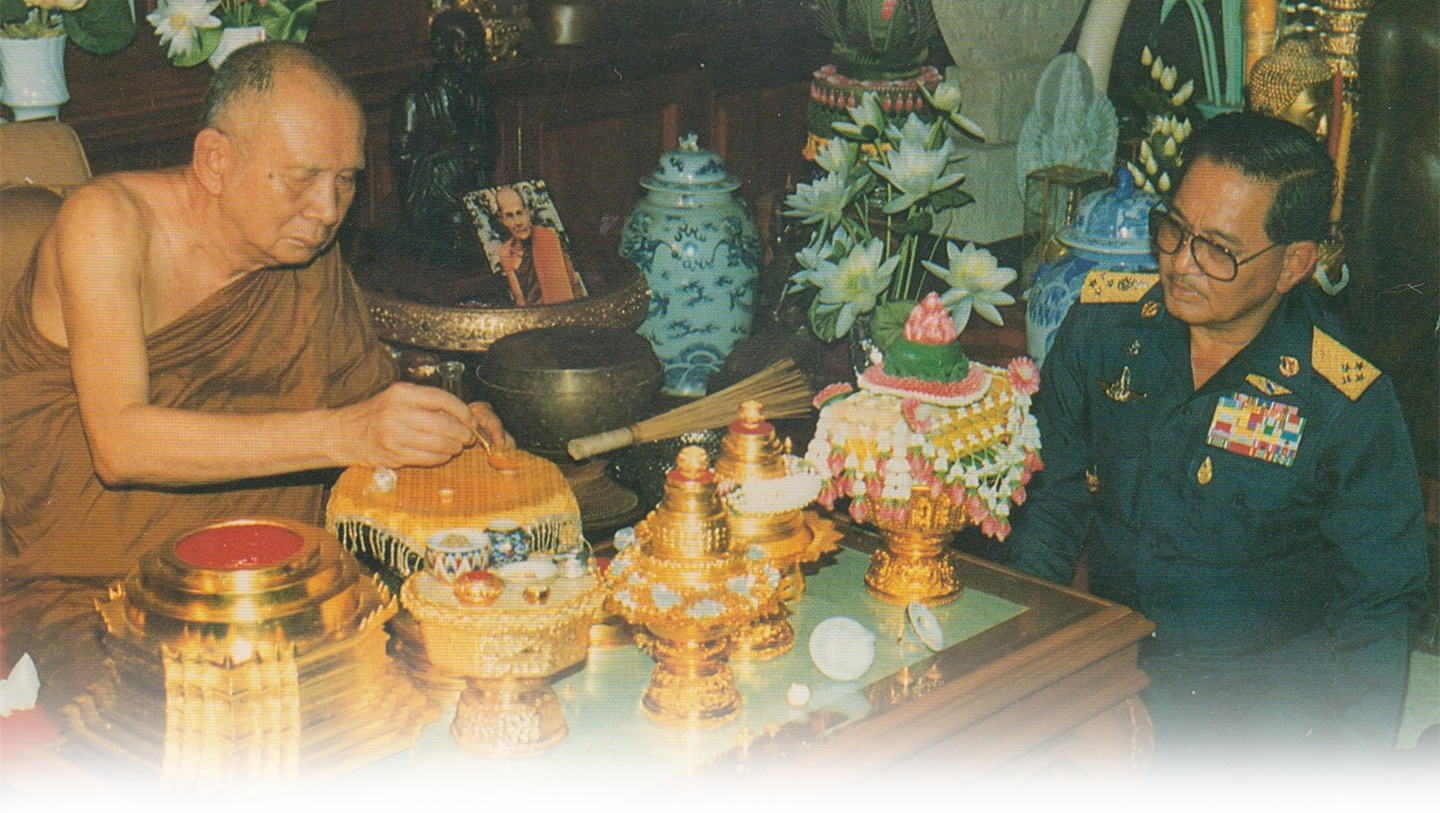
Somdet Phra Nyanasamvara, Thailand’s Supreme Patriarch, Packed Up Buddha Relics
RTAF issued a letter to inform Queen Sirikit about progress of construction and asking for Buddha relics to put together and engage all of them to be enshrined at the top of the pagoda before rainy season comes.
Somdej Phra Nyanasamvara suggested to perform engaging Buddha relics ceremony on March 29th, 1992 at 02:19 p.m. and set the date to give his Buddha relics to RTAF on March 11th, 1992.
Plenty of Buddha relics which were packed at the bottom of model pagoda belong to faithful people donated. The second layer of model pagoda contains Buddha relics from RTAF Commander-in- Chief, the third layer from Sri Lanka, the fourth layer which is its top spared for packing Buddha relics from Queen Sirikit and the top triangle (banana blossom shape) for Buddha relics from Somdej Phra Nyanasamvara.
Queen Sirikit
Queen Sirikit gave Buddha relics to RTAF on Wednesday dated March 18th, 1992 at Bhubing Palace. Queen Sirikit gave a chance for ACM Kaset Rojchananil, RTAF Commander-in-Chief, and his fellows to visit and receive Buddha relics to be enshrined on top triangle of the pagoda. She poured holy water onto Buddha relics and packed them into the golden casket by herself. After she gave it to RTAF Commander-in- Chief, she talked with visitors with happiness.
In this auspicious occasion, RTAF Commander-in- Chief gave 90-centimeters-high model Phra Buddha Sirikit Dighayumonggol Buddha image which was carved out of pure white jade stone from People’s Republic of China, along with some of commemorative medals from Nabhamethanidol pagoda’s construction.
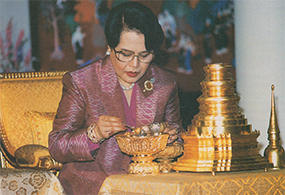

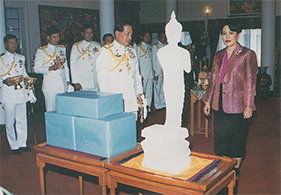
Buddha Relics Celebration Ceremony

Buddha Relics Celebration Ceremony
The celebration at Bangkok was held at Navaminda Kasatriyadhiraj Royal Air Force Academy on March 19th, 1992 which is the next day Queen Sirikit gave her personal Buddha relics to RTAF.
When the celebration started, RTAF Commander-in- Chief engaged Buddha relics from RTAF conference room onto the chariot and moved the procession to the Mandapa (a pillared outdoor hall or pavilion for public rituals).
After that, RTAF Commander-in- Chief performed worship ritual and invited spirits of RTAF officers’ parents to join this ritual. Then he laid down flower tray with pedestal to worship Buddha relics and lighted up candles and incense to worship the Three Gems. Buddhist monks chanted. After Buddhism rituals were done, senior RTAF officers, general RTAF officers, RTAF employees along with their families and people nearby who came to join this celebration went there to give flowers and bow to pay homage Buddha relics thoroughly until midnight.
At night, there were entertainments until midnight. It was greatly supported by Nititad Promotion Co.,Ltd. who brought many concerts and also lived at TV channel 9, too.
The celebration ended around midnight. ACM Anan Kalintha, Deputy Commander-in- Chief RTAF, engaged Buddha relics back to RTAF conference room in order to wait for an engagement to make another celebration in Chiang Mai again.
RTAF organized celebration again in Chiang Mai on March 29th, 1992 for Chiang Mai people and nearby provinces could come and worship Buddha relics altogether. RTAF Commander-in- Chief has waited at Wing 41 and then he engaged Buddha relics from the airplane and put them on the chariot which was prepared by Wing 41. Then the procession moved to the Three Kings monument, in front of the old Chiang Mai town hall to perform ceremony to welcome Buddha relics to Chiang Mai.
The Buddha relics procession was organized in Lanna style. It was a beautiful and looked different, hardly seen because it will be organized only for important royal ceremonies. A marching band from Wattanothaipayap school led the procession, followed with elephants parade, incantation objects parade, worship objects parade, victory flags parade, Nantha-peri drums parade, Wing 41 officers parade, parade of chariot carrying model Phra That Hariphunchai pagoda with Buddha relics inside. The end of the procession is RTAF Commander-in- Chief and attendants’ cars parade.
Elephant Flags Parade.
Parade attendants dressed ancient soldier uniforms, holding elephant flags and victory flags as signs of victory of the General. In this case, it refers to Buddha’s victory is elegant for Buddhism, worth all tributes.
Cambered Chatra Parade.
It contained incantation objects including eight necessities of a Buddhist monk for high level, means Buddha was an emperor.
Ton Phueng (Bee-Waxed Flowers on a Tray with Pedestal) Parade. It consisted of trees, Ton Maak Soom (betel nut coop on a tray with pedestal), Ton Maak Beng (cone of folded banana leaves on a pedestal of banana stalk pith) and so on. Parade attendants dressed with male Thai-Lanna uniforms. These Ton Phuengs are flowers for worship and celebrate Buddhism. They are use in incantation ceremony. So this considered as luck for welcoming Buddha relics into Chiang Mai.
Mae Oui’s (Women Elders) Parade.
In this parade, each Mae Oui hold victory flags (Tung Jai) to be a sign of dharma victory that people can see from afar. This victory is not only notifying human to know, but also notify angels to acknowledge and appreciate, too.
Nantha-peri Drums Parade.
It’s a kind of royal accessories using in royal parade. There are 3 kinds of drums in Chiang Mai as follows;
1. Nantha-peri drum
2. Klong Sabudchai (Lanna Encouraging Drum)
3. Klong Yao (long drum)
To take Nantha-peri drum into this parade this time is to admire Buddha, to announce everyone to know about Buddha relics holiness, just like olden Lanna saying that “If there’s drum sound, there’s Buddhism. Seven days without drum sound, Buddhism declined.”
Next to Nantha-peri drum parade, there was a parade of 5-tiered chatra. This represents 5 fevers we shall remind ourselves as follows;
1. Buddha’s favor
2. Dhamma’s favor
3. Buddhist monk’s favor
4. Parents’ favor
5. Teacher’s favor
When the procession arrived Chiang Mai stadium, they engaged Buddha relics from chariot to mandapa. There were Lanna ladies scattered worshipped flowers over along the way. There was an entertainment at night such as movies and concerts from Nititad Promotion Co.,Ltd.
RTAF has performed engaging ceremony of Buddha relics to be enshrined on the top triangle of the pagoda, organized an incantation ceremony and made a ritual to open Phra Buddha Dighayumonggol’s eyes. Meanwhile, they also engaged 100 of model Phra Buddha Dighayumonggol statues sized 45 centimeters which the Construction Board made them to give to major donors as commemoration, and Phra Khum Klao (protection Buddha Amulets) which will be packed up inside top triangle of the pagoda as Buddha worship, in this incantation ceremony, too. They used pagoda’s hall to perform this ceremony.
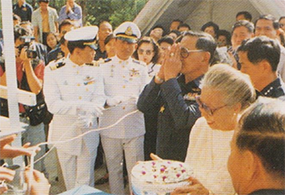
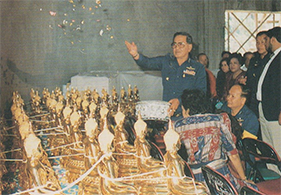
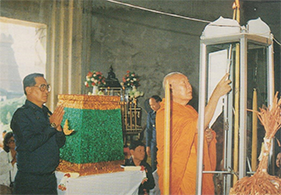
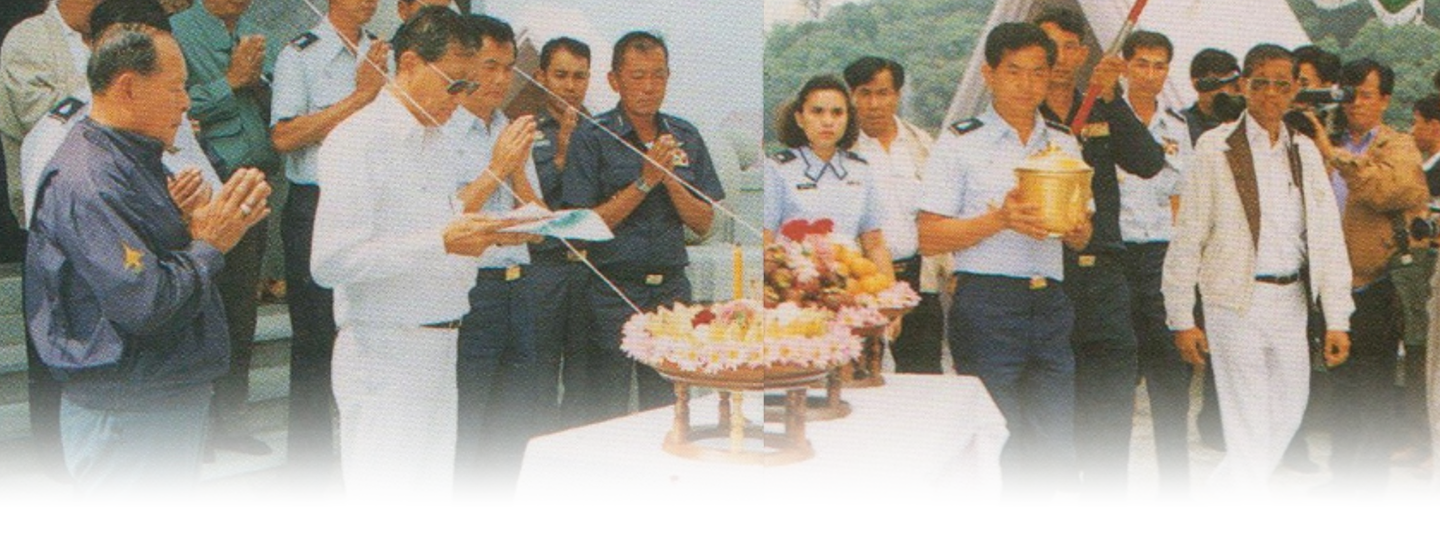
Queen Sirikit gave RTAF Commander-in- Chief Buddha images and Buddha Amulets to engage into Nabhapolphumisiri pagoda as follows;
1. Buddha image “Phra Buddha Lokkanat Sirikhun” made out of silver, lap size is 9 inches, its base is 15 inches wide. Its height from base to its hair is 20 inches. Its buns and monogram “SK” is made out of gold metal. On its back carved its name and number 62 of its sequence.
2. 2 of Buddha images “Phra Buddha Lokkanat Sirikhun” made out of metal, lap size is 5 inches, its base is 9 inches wide and it’s 12 inches high, carved monogram “SK” with silver metal.
3. 61 of Buddha Amulets “Somdej Nang Phaya Chitlada” made out of gold and metal in 3 different sizes.
4. 560 of Buddha Amulets “Somdej Nang Phaya Chitlada” made out of mixed metal in 2 different sizes.
5. 61 of Buddha Amulets “Phra Sankachai SK” made out of gold metal in 3 different sizes.
6. 560 of Buddha Amulets “Phra Sankachai SK” made out of mixed metal. These Buddha images and Buddha Amulets Queen Sirikit donated are the ones that Prime Minister Office made for royal charity in an auspicious occasion of her 5 circle birthday. She offered some part of them to be kept in major pagodas of Thailand as follows;
Nabhapolphumisiri pagoda, Chiang Mai
Phra Pathom Chedi, Nakhon Pathom
Maha Chakri Pipat pagoda
Nyanansamvararam temple, Chonburi
Phra That Phanom Pagoda, Nakhon Phanom
Phra Borommathat Chedi, Nakhon Sri Thammarat
กRTAF has performed formality of packing Buddha images and given Buddha Amulets in Nabhapolphumisiri pagoda on March 9th, 1993, ACM Somsak Kusalasai, Director of Construction Board, acting RTAF Commander-in- Chief as president of the ceremony. Mr.Banchop Chantimangkool, acting Prime Minister Secretary, along with Construction Committee and officers from Office of Prime Minister Secretary, attended.
Replicated Hariphunchai pagoda is a container for Buddha relics which will be enshrined on the top triangle of the pagoda. It was designed and molded by Mr.Laemsingh Disthaphan. It’s 34 centimeters wide, 65 centimeters high and weight around 10 kilograms. It can be split into 5 parts. Its base is for packing Buddha relics from faithful people. Upper part for packing Buddha relics from RTAF Commander-in-Chief, from Sri Lanka, from Queen Sirikit and from Somdej Phra Nyanasamvara, the Supreme Patriarch of Thailand respectively.
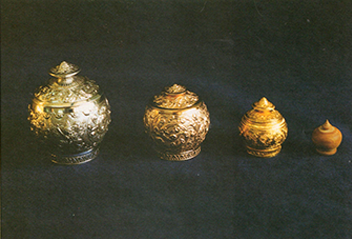
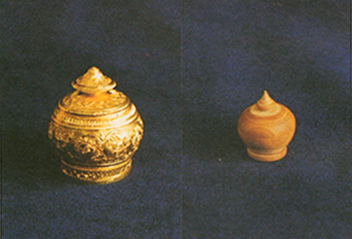
The golden caskets used for pack up Buddha relics from Queen Sirikit was made out of core of sandalwood for the most inside layer. Inside that layer is padded with cotton piled up inside golden casket, pink gold casket, and silver casket, total 4 layers. If we count replicated Hariphunchai pagoda, it will be 5 layers in total.
For the casket of Somdej Phra Nyanasamvara, from Sri Lanka and RTAF Commander-in- Chief’s are double layers caskets. Inner layers are cored sandalwood caskets, outer layers are golden caskets.
Miscellaneous
All 3 years of construction came a lot of unexpected problems. Especially in decoration process which must be very neat and skillful. Some part they had to fix them again and again. But every concerned party such as Mr.Narongrit Ouyanon, owner of Ritti Ouyanon limited partnership, Mr.Sakchan Silasaengroong, owner of Sak Sila Panich shop, who took over the job of carving royal duties, Mr.Wanchoke and Mr.Wanchai Krissadamahasakul, who took over job of glazed-colored baked clay around the pagoda’s surface. Also Mr.Pradit Sriwichainan, who took over colored bake clay sculptures at the terrace’s arches. They all willing to fix their jobs and remake them with pleasure to deliver the best jobs for Her Majesty the Queen Sirikit in this auspicious occasion.

